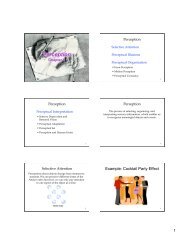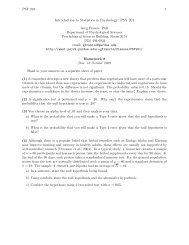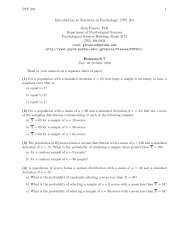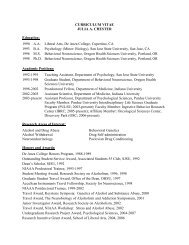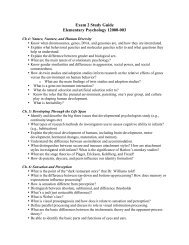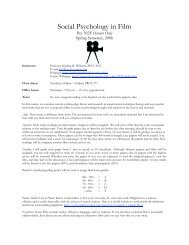Maxims or Myths of Beauty? A Meta-Analytic and Theoretical Review
Maxims or Myths of Beauty? A Meta-Analytic and Theoretical Review
Maxims or Myths of Beauty? A Meta-Analytic and Theoretical Review
Create successful ePaper yourself
Turn your PDF publications into a flip-book with our unique Google optimized e-Paper software.
406<br />
Table 11<br />
C<strong>or</strong>respondence Between Hypotheses <strong>and</strong> Results<br />
LANGLOIS ET AL.<br />
Hypothesis Prediction<br />
Social the<strong>or</strong>y<br />
1. Within-culture agreement (high reliability)<br />
2. Between-culture agreement (low reliability)<br />
3. Agreement higher f<strong>or</strong> female than male faces<br />
4. Agreement higher f<strong>or</strong> older than younger judges<br />
5. Differential judgment<br />
6. Differential treatment<br />
7. Differential behavi<strong>or</strong><br />
8. Differential self-views<br />
9. Attractiveness m<strong>or</strong>e imp<strong>or</strong>tant f<strong>or</strong> females than males<br />
10. Differential judgment <strong>and</strong> treatment imp<strong>or</strong>tant during childhood<br />
11. Behavi<strong>or</strong>al differences cumulate <strong>and</strong> increase over time<br />
12. Behavi<strong>or</strong> caused by judgment <strong>and</strong> treatment<br />
Mate-selection the<strong>or</strong>y<br />
1. Within-culture agreement (reliability) about attractiveness<br />
2. Between-culture agreement (reliability) about attractiveness<br />
3. Agreement higher f<strong>or</strong> female than male faces<br />
4. Agreement higher f<strong>or</strong> older than younger judges<br />
5. Differential judgment<br />
6. Differential treatment<br />
7. Differential behavi<strong>or</strong><br />
8. Attractiveness m<strong>or</strong>e imp<strong>or</strong>tant f<strong>or</strong> females than males<br />
9. Adult-centered the<strong>or</strong>y: attractiveness either not imp<strong>or</strong>tant f<strong>or</strong><br />
children <strong>or</strong> ign<strong>or</strong>ed f<strong>or</strong> children<br />
10. Judgment <strong>and</strong> treatment caused by target behavi<strong>or</strong><br />
Good-genes the<strong>or</strong>y<br />
1. Within-culture agreement<br />
2. Between-culture agreement<br />
3. Similar (high) level <strong>of</strong> agreement f<strong>or</strong> male <strong>and</strong> female faces<br />
4. Similar (high) level <strong>of</strong> agreement f<strong>or</strong> older <strong>and</strong> younger judges<br />
5. Differential judgment<br />
6. Differential treatment<br />
7. Differential behavi<strong>or</strong><br />
8. Attractiveness m<strong>or</strong>e strongly related to status <strong>and</strong> fitness than<br />
to other types <strong>of</strong> characteristics<br />
9. Attractiveness equally imp<strong>or</strong>tant f<strong>or</strong> both sexes<br />
10. Behavi<strong>or</strong>al differences evident early<br />
11. Judgment <strong>and</strong> treatment caused by target behavi<strong>or</strong><br />
Differential parental solicitude the<strong>or</strong>y<br />
1. Within-culture agreement<br />
2. Between-culture agreement<br />
3. Similar (high) level <strong>of</strong> agreement f<strong>or</strong> male <strong>and</strong> female faces<br />
4. Differential judgment<br />
5. Differential treatment<br />
6. Differential behavi<strong>or</strong><br />
7. Attractiveness equally imp<strong>or</strong>tant f<strong>or</strong> both sexes<br />
8. Behavi<strong>or</strong>al differences evident early<br />
9. Judgment <strong>and</strong> treatment caused by target behavi<strong>or</strong><br />
opment <strong>of</strong> traits desired by each gender. The the<strong>or</strong>y predicts that<br />
higher reliability should be obtained f<strong>or</strong> female rather than male<br />
attractiveness because attractiveness is especially imp<strong>or</strong>tant as an<br />
indicat<strong>or</strong> <strong>of</strong> reproductive fitness in women (L. A. Jackson, 1992).<br />
However, this is not what the data show. Instead, we found a<br />
surprising lack <strong>of</strong> gender differences in the four different meta-<br />
analyses <strong>of</strong> the reliability <strong>of</strong> attractiveness judgments.<br />
Second, because men prefer <strong>and</strong> seek attractive women, by<br />
extension, men should also judge <strong>and</strong> treat them m<strong>or</strong>e positively<br />
(G. F. Miller, 1998). Women should fav<strong>or</strong> men with resources<br />
m<strong>or</strong>e than they fav<strong>or</strong> attractive men. Thus, attractiveness should be<br />
m<strong>or</strong>e imp<strong>or</strong>tant in how men judge <strong>and</strong> treat women than in how<br />
Supp<strong>or</strong>ted<br />
Not supp<strong>or</strong>ted<br />
Not supp<strong>or</strong>ted<br />
Not supp<strong>or</strong>ted<br />
Supp<strong>or</strong>ted<br />
Supp<strong>or</strong>ted<br />
Supp<strong>or</strong>ted<br />
Partially supp<strong>or</strong>ted<br />
Not supp<strong>or</strong>ted<br />
Supp<strong>or</strong>ted<br />
Insufficient primary research to evaluate<br />
Insufficient primary research to evaluate<br />
Supp<strong>or</strong>ted<br />
Supp<strong>or</strong>ted<br />
Not supp<strong>or</strong>ted<br />
Not supp<strong>or</strong>ted<br />
Supp<strong>or</strong>ted<br />
Supp<strong>or</strong>ted<br />
Supp<strong>or</strong>ted<br />
Not supp<strong>or</strong>ted<br />
Not supp<strong>or</strong>ted<br />
Insufficient primary research to evaluate<br />
Supp<strong>or</strong>ted<br />
Supp<strong>or</strong>ted<br />
Supp<strong>or</strong>ted<br />
Supp<strong>or</strong>ted<br />
Supp<strong>or</strong>ted<br />
Supp<strong>or</strong>ted<br />
Supp<strong>or</strong>ted<br />
Not supp<strong>or</strong>ted<br />
Supp<strong>or</strong>ted<br />
Partially supp<strong>or</strong>ted: behavi<strong>or</strong> differences present during childhood<br />
Insufficient primary research to evaluate<br />
Supp<strong>or</strong>ted<br />
Supp<strong>or</strong>ted<br />
Supp<strong>or</strong>ted<br />
Supp<strong>or</strong>ted<br />
Supp<strong>or</strong>ted<br />
Supp<strong>or</strong>ted<br />
Supp<strong>or</strong>ted<br />
Partially supp<strong>or</strong>ted: behavi<strong>or</strong> differences present during childhood<br />
Insufficient primary research to evaluate<br />
women judge <strong>and</strong> treat men (Buss & Barnes, 1986; Buss &<br />
Schmitt, 1993; L. A. Jackson, 1992). Our findings did not supp<strong>or</strong>t<br />
these predictions f<strong>or</strong> either judgment <strong>or</strong> treatment. We found no<br />
gender differences in the imp<strong>or</strong>tance <strong>of</strong> attractiveness, contrary to<br />
the predictions <strong>of</strong> mate-selection the<strong>or</strong>y but consistent with the<br />
findings <strong>of</strong> Eagly et al. (1991) in their meta-analysis <strong>of</strong> the<br />
stranger-attribution literature. We note, however, that f<strong>or</strong> treat-<br />
ment, there were few studies in which men <strong>and</strong> women were<br />
directly compared <strong>or</strong> in which same-sex treatment was examined.<br />
Thus, this hypothesis has not yet received sufficient attention from<br />
primary research. Most <strong>of</strong> the extant primary research that supp<strong>or</strong>ts<br />
mate-selection the<strong>or</strong>y is almost entirely based on paper-<strong>and</strong>-pencil


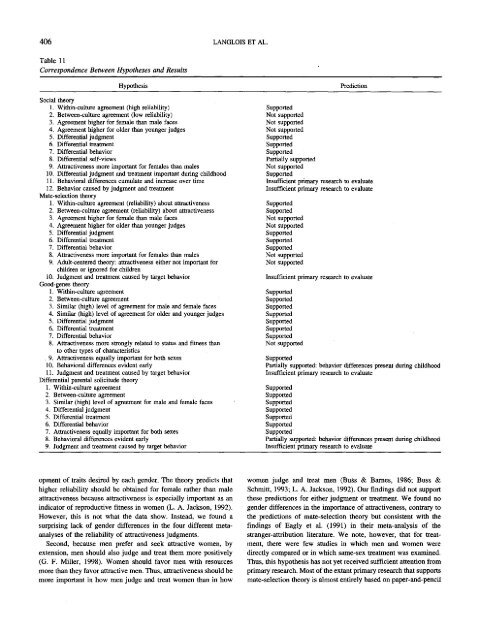


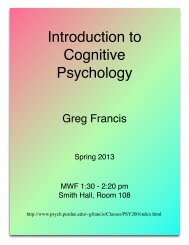

![Exam 4 Study Guide[1]](https://img.yumpu.com/45196739/1/190x245/exam-4-study-guide1.jpg?quality=85)
